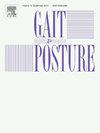Age-related changes in mediolateral stability control during walking
IF 2.2
3区 医学
Q3 NEUROSCIENCES
引用次数: 0
Abstract
Background
Younger adults (YA) may primarily regulate mediolateral stability during walking through proactive control of net ground reaction force orientation, with residual instability during challenging gait conditions mediated by reactive force generation later in the gait cycle. We sought to understand if older adults (OA) use a similar reactive strategy to regulate mediolateral stability during walking when proactive control is limited.
Research question
Do gait velocity and step width constraints differentially alter mediolateral gait stability control among healthy younger (18−35) and older (>65) participants?
Methods
28 YA and 28 OA performed normal (NW), fast (FW) and narrow base (NBW) walking conditions across an instrumented walkway. Mediolateral stability was quantified by the minimum mediolateral margin of stability (MoSML). The frontal-plane eccentricity of the GRFnet was calculated at two peaks (P1 and P2) following foot-contact. Age- and task-related differences in the magnitude and timing of kinematic and kinetic outcome variables were examined.
Results
OA exhibited reduced minimum MoSML, alongside reductions in the P2 eccentricity in both NW and FW conditions. No age-related differences in MoSML were observed during NBW, although OA exhibited a significantly increased P2 magnitude, which was delayed within the gait cycle. No age-related differences in P1 magnitude or timing were noted, nor were there age-related differences in MoSML at the onset of double support.
Significance
OA may regulate mediolateral stability through foot-placement, when possible. With constraints on foot placement, OA are able to compensate by generating a sufficient, but delayed, P2 eccentricity to counter instability arising during double support.
求助全文
约1分钟内获得全文
求助全文
来源期刊

Gait & posture
医学-神经科学
CiteScore
4.70
自引率
12.50%
发文量
616
审稿时长
6 months
期刊介绍:
Gait & Posture is a vehicle for the publication of up-to-date basic and clinical research on all aspects of locomotion and balance.
The topics covered include: Techniques for the measurement of gait and posture, and the standardization of results presentation; Studies of normal and pathological gait; Treatment of gait and postural abnormalities; Biomechanical and theoretical approaches to gait and posture; Mathematical models of joint and muscle mechanics; Neurological and musculoskeletal function in gait and posture; The evolution of upright posture and bipedal locomotion; Adaptations of carrying loads, walking on uneven surfaces, climbing stairs etc; spinal biomechanics only if they are directly related to gait and/or posture and are of general interest to our readers; The effect of aging and development on gait and posture; Psychological and cultural aspects of gait; Patient education.
 求助内容:
求助内容: 应助结果提醒方式:
应助结果提醒方式:


